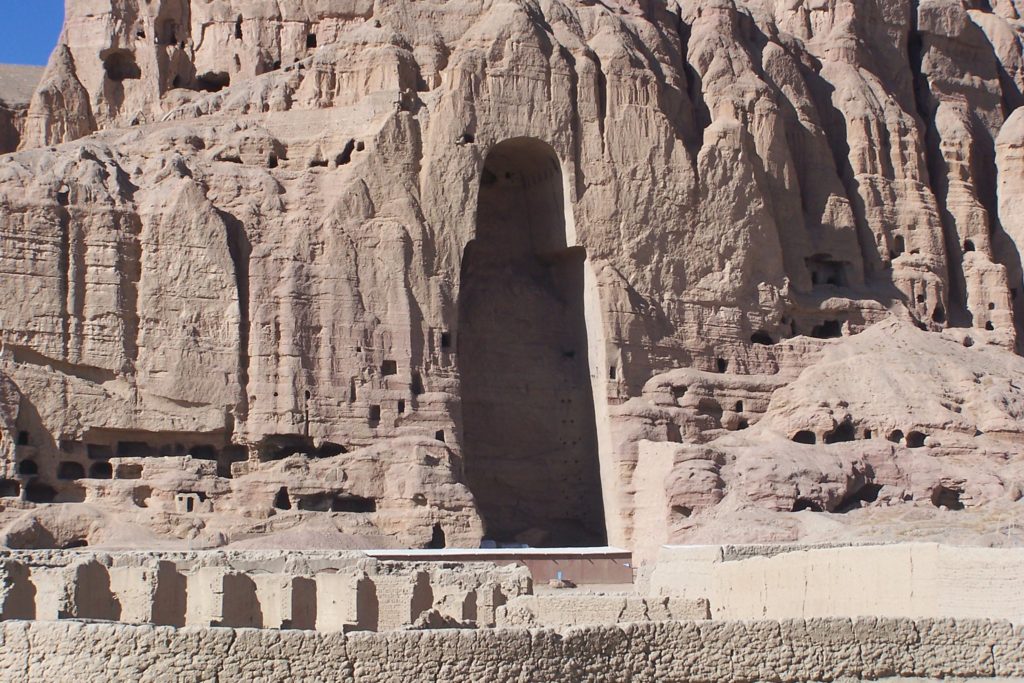In a country bursting with historic landmarks and cultural riches, the Bamiyan Valley stands out as one of Afghanistan’s most important and impressive heritage sites. Despite its relatively remote location in Central Afghanistan, the city of Bamiyan and the surrounding area is known today as a vibrant hub of Afghan culture and creativity from both past and present. Read on for a look at some fascinating facts you might not know about this amazing site.
1. Bamiyan is the former home of the Buddhas of Bamiyan.

Bamiyan’s original claim to fame is the historic Buddhas of Bamiyan—two monumental Buddha statues that were carved directly into the sandstone cliffs of the valley roughly 1,500 years ago. An awe-inspiring example of Afghanistan’s ancient Buddhist heritage, which had all but disappeared from the country by the 10th century, the giant sculptures were unfortunately destroyed in 2001 as a result of Afghanistan’s internal conflict. However, in response to this cultural tragedy, scholars and experts around the world have been working ever since to preserve the other significant archaeological material in the area, and to one day perhaps rebuild the Buddhas.
2. The world’s first oil paintings can be found at Bamiyan.
If you think that oil painting was first developed during the European Renaissance, it’s time to think again. In addition to the Buddha statues, the Bamiyan Valley boasts an incredible system of more than 1,000 caves that were once used as Buddhist monasteries, chapels, and sanctuaries. Inside these caves, the remains of striking wall paintings created using the world’s first oil paints can be found, along with other decorative features and small carved figures.
3. Bamiyan was an important stopping point on the Silk Road.
Although the location of Bamiyan seems somewhat isolated and remote today, the area was once a globalized and cosmopolitan center along the fabled Silk Road trading route. Linking ancient Rome with China and India, the Silk Road saw not only goods but also philosophies, religions, and ideas passed back and forth between East and West. Afghanistan, particularly Bamiyan, was at the very heart of the route. In addition, Alexander the Great himself is recorded as having passed through Bamiyan, while Mani, the mystic and philosopher who founded the Manicheans, is believed to have lived and studied there.
4. Bamiyan is a UNESCO World Heritage Site.
The cultural landscape and archaeological remains of the Bamiyan Valley constitute one of the two UNESCO World Heritage Sites in Afghanistan (the other is the famous Minaret of Jam).
Bamiyan was added to the World Heritage list in 2003 in recognition of its outstanding universal cultural value, particularly as an example of Afghanistan’s Buddhist heritage, and of Western Buddhism in general. At the same time, the site was also included on the List of World Heritage in Danger, which identifies and monitors important cultural heritage sites whose ongoing existence may be threatened by factors such as environmental damage or security risks. (In recent years, Afghanistan has been working closely with the Japanese government to fulfill the conditions necessary for removing Bamiyan from the Danger list.)
5. Bamiyan is a member of the UNESCO Creative Cities Network.
In 2004 UNESCO launched its Creative Cities Network (UCCN), an initiative developed to foster cooperation and support among global cities that prioritize creativity as part of their sustainable urban development efforts. In 2015 Bamiyan became the first urban center from Afghanistan—and all of Central Asia—to join the network.
This membership is not only a reflection of Bamiyan’s rich cultural past but also of the investments the area is making in the present-day areas of crafts and folk art (one of the seven categories of creativity covered by the UCCN). For example, Afghanistan’s Department of Rural Rehabilitation and Development has conducted local carpet weaving projects that employ some of the region’s most vulnerable people.
7. Bamiyan has been suggested as the site of the Garden of Eden.
For centuries, people have speculated about which real-world places might have been the site of the Garden of Eden, and interestingly enough, Bamiyan has been proposed as a possibility. In 1799, Captain Francis Wilford, a somewhat eccentric scholar, suggested in the journal Asiatic Researches that because four rivers flow out of the Bamiyan Valley, the site could be the location of the biblical garden.
Whether or not you believe this claim, there seems to be little question that Bamiyan is beautiful enough to be considered an earthly paradise. Poised just below the spectacular ranges of the Hindu Kush, the Bamiyan Valley is lush and fertile, full of orchards, pastures, and flowers, and its isolated location (by present-day standards) has helped protect it from much of the conflict that has troubled other parts of Afghanistan. It’s therefore perhaps not surprising to learn that Bamiyan can be translated as “land of shining light.”

